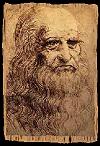|
Experts continue to debate the authenticity of paintings attributed to Leonardo. Doubts remain over almost all of his paintings with virtually every one presenting some kind of a problem. As a result, the past century has seen paintings continuously added and removed from the list of those credited to Leonardo, with his religious works looked upon with the least doubt. Having said that, the Annunciation has been the subject of strong debate.
Both the Uffizi Gallery in Florence, and the Louvre in Paris, have versions of the Annunciation generally attributed to Leonardo. That which appears in the Uffizi Gallery was acquired in 1867 from the monastery of San Bartolomeo of Monteoliveto, (Florence). At this stage it was ascribed to Domenico Ghirlandaio and this continued until 1869, when nineteenth century experts recognised it as being from the hand of a young da Vinci. In 1875 the Louvre copy was also pronounced to be by Leonardo.
This then created immense debate between the experts, with the result that most now agree Leonardo had some involvement in the Uffizi version. The painter of the Louvre version (c. 1478-1485) remains doubtful. Certainly the small panel is unusually perfect, particularly the wings of the angel, but documented evidence strongly suggests this predella is part of an altarpiece painted for the Cathedral of Pistoia, recorded as being a Verrocchio and executed by Lorenzo di Credi. Another section has been located in Detroit which helps to confirm this theory, along with the flowers lacking Leonardo's sense of 'growth' and the draperies showing the characteristics of other Credi artwork. Paintings by Leonardo are frequently attributed to Credi and vise versa as the two were studying with Verrocchio at the same time. Still, it is worth remembering that the empty frame for this painting sat in Verrocchio's workshop for around ten years and there was plenty of opportunity for Leonardo to take up work on the panel during this time. As for the Uffizi version, certain proof exists that Leonardo did have a hand in this painting. For a long time the large wood panel (seven feet by three feet) was attributed to Ghirlandaio. Evidence of Leonardo's involvement came in the form of a drawing made of the angel's sleeve which is undoubtedly his and is one of the few early drawings that has been positively identified as being from his hand. Leonardo's use of light and shade giving a shadowy effect known as 'leonardesque' is also obvious, despite the bad condition of the painting. The robes are discoloured by old retouching and thick varnish, and the entire surface is extremely dirty. At some stage the angel's wings have been severely retouched and crudely lengthened in the process. The original short wings are thought to have been painted directly from the wings of a bird. Note the human presence of ships shown in the background (this is very unusual for Leonardo).
This painting was executed around 1472-1475 and is dated by the marble sarcophagus dividing the figures. It was copied from Piero de Medici's tomb which Verrocchio carved in the church of San Lorenzo. In the panel an angel is shown kneeling before the Virgin, to tell her that she will soon become the mother of Christ. The messenger holds a Madonna lily, and this along with the enclosed garden, symbolises virginity. Experts do not rave over this panel like they rave over the Mona Lisa. With its prominent lectern, and awkward composition and perspective, this artwork has sometimes been termed almost amateurish. Indeed, it does appear to have been painted by an artist still trying to understand the tricks of perspective. Horizontally the vanishing point is precisely in the centre of the picture, vertically it is two-thirds of the way up. Another obvious mistake is the Virgin's right hand placed on a lectern which is closer to the viewer than she is. Some historians strongly support the idea that the Uffizi painting was the first wholly produced by Leonardo, others hesitate to discredit him by labelling it his work, though it must be remembered that he was only in the region of 20-21 years old when this was painted and it then becomes a quite miraculous work from such a young artist. Despite these composition errors the paintings both create a strong atmosphere and are particularly interesting works because of their early date. |
|



